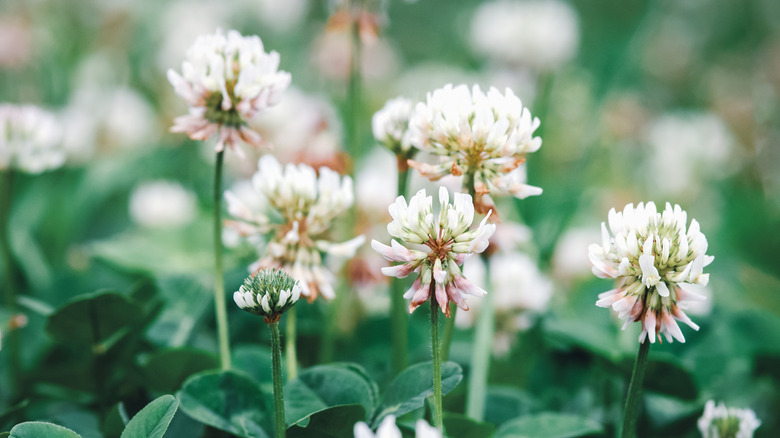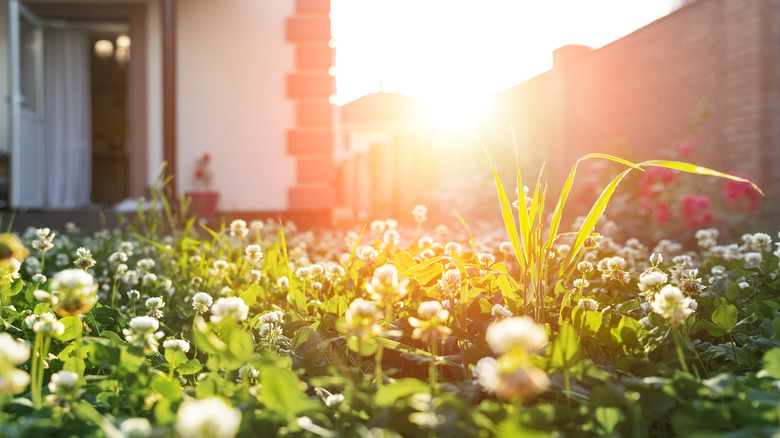If you’re after a lush, green lawn but dread the thought of weekend-long yard work, excessive watering, and dealing with endless bags of fertilizer, Dutch clover (Trifolium repens) might just be the solution you’ve been looking for. This little plant packs a punch in the world of gardening, offering both beauty with its white flowers and a practical, low-maintenance approach to achieving that perfect lawn look. Also known as white clover, Dutch clover originally hails from Europe but has made its way across the U.S., feeling at home in a variety of climates. It’s pretty easy to spot with its trademark trifoliate leaves and white blossoms, which seem to be a beacon for bees and butterflies. Standing up to 8 inches tall when it blooms, it spreads through seeds and creeping stolons, creating a dense, effective ground cover.
It also loves the cooler seasons, which basically means that it can thrive in the cooler temperatures of spring and fall. They often start growing early in the season and can even tolerate a light frost, making Dutch clover an ideal choice for gardeners in USDA hardiness zones 3 to 10. Its ability to perform best in cooler weather also means it will be one of the first plants to green up in spring, providing an early start to your lawn’s beauty. As it’s also a perennial, it sticks around year after year, and can shift to an annual lifecycle in the warmer southern climates, generally offering a solid three to five years of green glory.
The benefits of Dutch clover for lawns

Growing this clover in your yard comes with a mix of good looks and handy benefits. It’s got a tough nature that gardeners love, not to mention that it’s pretty easy to take care of. You can plant it in just about any soil and it won’t get thirsty like regular grass, making it perfect if you’re in a drought-prone area or if you’re trying to cut back on water use. The cool part? It’s quite resistant to diseases. But here’s where it gets even better: Dutch clover doesn’t roll out the welcome mat for pests and diseases that usually mess with lawns. Fewer pests means you can skip a lot of the chemical stuff you might use on other plants. You don’t have to spray as much, making your yard a safer spot for pets and backyard critters. It’s also a champ at crowding out weeds, so you get a neat, tidy look without breaking a sweat.
Moving on to mowing. With Dutch clover, you might just forget where you parked your lawn mower. It grows at a leisurely pace compared to regular grass, which is a win for your free time. And when it comes to soil health, Dutch clover grabs nitrogen right out of the air and fixes it in the ground. This means your soil gets richer without anyone having to pour on fertilizer. All these perks add up to Dutch clover being a top-notch, eco-friendly pick if you want a gorgeous lawn without the high maintenance.
How to establish and maintain a Dutch clover lawn

Starting a Dutch clover lawn is straightforward and skips over the fuss of traditional grass setups. First things first: Clear the deck by getting rid of any existing grass or weeds. Give the soil a gentle turn to loosen it up — nothing too intense, just enough to make it welcoming for new seeds. The magic happens in spring or fall when the mild weather makes the ground just right for seeds to wake up and grow. Spread those Dutch clover seeds evenly, then rake them lightly to ensure they’re all tucked in with good contact with the soil. Keep the ground moist but not soggy, watering just enough to encourage those seeds to germinate and take root.
When it comes to caring for your Dutch clover, you’ll find it’s a walk in the park. Mowing is almost optional. Really, you might only need to mow to keep things looking tidy. As for watering, Dutch clover doesn’t thirst much. It’s drought-tolerant, so only water during really dry periods. And fertilizing? You can pretty much skip it. The plant is a self-sufficient plant that fixes its own nitrogen, naturally enriching the soil without the need for extra fertilizer. All in all, you get both aesthetic and practical benefits of growing this clover in your yard. It also meshes well with other lawn favorites like red clover and Kentucky bluegrass, making for a robust, attractive lawn mix.



